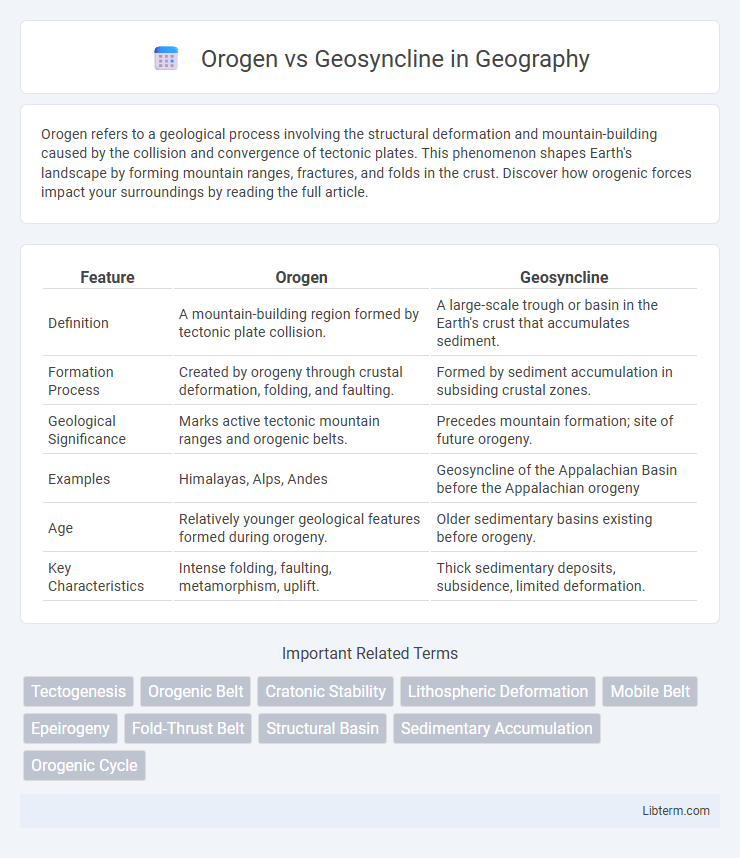Orogen refers to a geological process involving the structural deformation and mountain-building caused by the collision and convergence of tectonic plates. This phenomenon shapes Earth's landscape by forming mountain ranges, fractures, and folds in the crust. Discover how orogenic forces impact your surroundings by reading the full article.
Table of Comparison
| Feature | Orogen | Geosyncline |
|---|---|---|
| Definition | A mountain-building region formed by tectonic plate collision. | A large-scale trough or basin in the Earth's crust that accumulates sediment. |
| Formation Process | Created by orogeny through crustal deformation, folding, and faulting. | Formed by sediment accumulation in subsiding crustal zones. |
| Geological Significance | Marks active tectonic mountain ranges and orogenic belts. | Precedes mountain formation; site of future orogeny. |
| Examples | Himalayas, Alps, Andes | Geosyncline of the Appalachian Basin before the Appalachian orogeny |
| Age | Relatively younger geological features formed during orogeny. | Older sedimentary basins existing before orogeny. |
| Key Characteristics | Intense folding, faulting, metamorphism, uplift. | Thick sedimentary deposits, subsidence, limited deformation. |
Introduction to Orogen and Geosyncline
Orogen refers to a structural feature formed by the large-scale processes of mountain building, typically involving the folding, faulting, and uplift of the Earth's crust. Geosyncline is a large-scale depression in the Earth's crust that accumulates thick sequences of sediments, often serving as the initial stage in the development of orogenic belts. Understanding the distinction between orogens and geosynclines is essential in geology for interpreting the processes of crustal deformation and mountain formation.
Defining Orogen: Key Features
Orogen refers to a structural feature formed by the intense folding, faulting, and metamorphism of the Earth's crust during mountain-building processes, typically occurring at convergent plate boundaries. Key features of orogens include linear mountain ranges, high-grade metamorphic rocks, and deep crustal roots indicative of crustal shortening and thickening. Unlike geosynclines, which are sedimentary troughs that may precede orogenic development, orogens represent the mature stages of tectonic deformation and crustal uplift.
Understanding Geosyncline: Core Concepts
Geosynclines are large-scale, elongated troughs in the Earth's crust where thick sediment accumulations occur, playing a pivotal role in mountain building processes. They represent zones of subsidence and sedimentation that eventually undergo deformation, folding, and uplift during orogenic events. Understanding geosynclines involves recognizing their function as precursor structures to orogens, marking regions of crustal convergence and intense tectonic activity.
Historical Development of Orogen and Geosyncline Theories
The historical development of orogen and geosyncline theories traces back to the 19th and early 20th centuries when geologists sought to explain mountain formation and sedimentary basin evolution. Geosyncline theory, proposed by James Hall and later refined by Eduard Suess and Emile Argand, described large-scale downwarped sediment accumulations that later folded to form mountains, while orogeny emerged from studies by geologists like Bailey Willis and John Wesley Powell emphasizing tectonic compression and crustal deformation. Advances in plate tectonics during the mid-20th century ultimately integrated these concepts, redefining orogens as active mountain-building zones linked to plate boundaries and rendering classical geosyncline models obsolete.
Tectonic Processes in Orogenesis
Orogenesis involves the tectonic processes of crustal deformation, mountain building, and metamorphism primarily driven by plate convergence, subduction, and continental collision within orogenic belts. In contrast, geosynclines represent large-scale sedimentary basins experiencing subsidence and sediment accumulation that precede orogenic uplift but lack significant crustal shortening or thickening. Understanding the tectonic mechanisms of orogeny, such as thrust faulting, folding, and crustal thickening, is essential in distinguishing active mountain-building zones from passive geosynclinal regions.
Geosynclinal Evolution and Sedimentation
Geosynclinal evolution involves the subsidence and accumulation of thick sedimentary sequences within elongated troughs formed by tectonic plate movements. Sedimentation in geosynclines primarily includes deep marine deposits such as shales, turbidites, and carbonates, continuously fed by erosion from adjacent highlands. Over geological time, continued sedimentation leads to the formation of complex folded and faulted structures when the geosyncline undergoes orogenic compression.
Differences Between Orogen and Geosyncline
Orogen refers to a mountain range or belt formed by tectonic plate collisions, characterized by intense folding, faulting, and metamorphism, whereas geosyncline is a large-scale depression in the Earth's crust that accumulates thick sedimentary layers over time. Orogens involve active orogenic processes like uplift and deformation, while geosynclines represent passive sedimentation zones prior to mountain building. The key difference lies in orogens being structural features created by compressional forces, whereas geosynclines are sedimentary basins that may later evolve into orogens.
Real-World Examples: Orogens and Geosynclines
The Himalayan orogen exemplifies a modern orogen formed by continental collision, producing mountain ranges through intense tectonic compression. The Appalachian geosyncline represents an ancient, subsiding basin filled with sediments that later deformed during orogeny. These cases illustrate how orogens develop from geosynclinal zones driven by plate tectonics and sediment accumulation.
Orogen and Geosyncline in Modern Plate Tectonics
Orogenes form through the convergence and collision of tectonic plates, creating mountain ranges via processes such as subduction, continental collision, and crustal thickening, which are key concepts in modern plate tectonics. Geosynclines, once considered large-scale structural depressions where sediments accumulated, are now understood as sedimentary basins often associated with subduction zones and forearc basins adjacent to active orogens. The modern plate tectonics framework reinterprets geosynclines as dynamic, evolving features within convergent plate margins that contribute to orogenic belt development.
Significance in Earth Sciences
Orogen and geosyncline are crucial concepts in Earth sciences for understanding mountain formation and sedimentary basin development. Orogen refers to the structural deformation and uplift resulting from plate tectonic processes, leading to mountain building, while geosyncline describes large-scale downwarped sedimentary basins that accumulate thick sediment sequences prior to orogeny. Studying orogeny and geosynclines enhances knowledge of crustal evolution, tectonic activity, and the geological history of Earth's lithosphere.
Orogen Infographic

 libterm.com
libterm.com